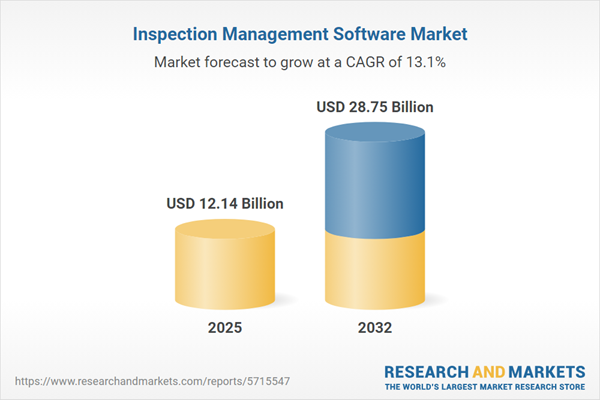Speak directly to the analyst to clarify any post sales queries you may have.
Inspection management software is reshaping compliance strategies and operational oversight as organizations transition toward more digital, agile frameworks. Senior decision-makers are focusing on scalable, data-driven solutions that ensure regulatory confidence, unify complex teams, and provide a foundation for future growth in an increasingly digital environment.
Market Snapshot: Inspection Management Software Market
The inspection management software market is experiencing significant expansion, propelled by the need for enhanced regulatory transparency and operational visibility. Enterprises operating in manufacturing, transportation, oil and gas, and healthcare are accelerating their adoption of these platforms. The move addresses challenges of data silos and inconsistent workflows by standardizing inspection processes. Digital inspection management supports unified audits and compliance monitoring, producing consistent, reliable audit trails. Seamless integration with core enterprise systems allows organizations to adapt quickly to evolving regulations and business needs, while maintaining oversight across diverse geographic regions and operational structures.
Inspection Management Software Market: Scope & Segmentation
This report offers a thorough assessment for senior executives seeking clear insights on inspection management software adoption, considering evolving industry expectations and regional nuances. Key segments analyzed include:
- Deployment Mode: Choices between cloud-based platforms and on-premises implementations cater to specific data privacy requirements, IT resource strategies, and the need for adaptable scaling across distributed sites.
- Component: Inspection management solutions are delivered through core functional modules, extensible vertical add-ons, and a suite of supporting services that encompass deployment, technical support, and ongoing maintenance—facilitating long-term stability and ease of use.
- Organization Size: Software platforms align with operational needs of small businesses, mid-sized organizations, and large enterprises, offering resource and process flexibility regardless of scale.
- End User Industry: Adoption is seen across manufacturing, oil and gas, transportation, and healthcare, supporting use cases from audit automation to enhanced risk management throughout high-compliance environments.
- Application: Inspection software addresses scenarios including food safety, fire regulation compliance, industrial process control, non-destructive inspections, asset monitoring, and workplace hazard verification.
- Region: Market coverage includes the Americas, EMEA, and Asia-Pacific, each presenting distinct compliance demands and adoption paces shaped by sector and regulatory climate.
- Prominent Vendors: Organizations rely on providers such as Intelex Technologies Inc., Gensuite LLC, ETQ Inc., SafetyCulture Pty Ltd, MasterControl Inc., AssurX Inc., ComplianceQuest Inc., AuditBoard Inc., Donesafe Pty Ltd, and Greenlight Guru Inc. for solutions built to support compliance and operational goals across diverse markets.
Key Takeaways: Strategic Insights for Optimizing Inspection Management Software Adoption
- Centralizing compliance management within a unified software platform standardizes workflows and improves transparency, helping organizations to reduce fragmentation and reinforce consistent operational procedures.
- Automated inspection data capture and workflow automation provide business leaders with real-time visibility, enabling prompt, data-driven decisions—especially valuable in asset-intensive and regulated sectors.
- Considering deployment strategies that incorporate cybersecurity needs and ensure compatibility with existing IT infrastructure enables smooth digital transformation and minimizes operational disruption.
- Technology-neutral software design promotes integration with enterprise and legacy systems, making it easier to automate processes and scale operations across multiple locations.
- Collaboration tools, structured workflow management, and workforce training features enhance change management and productivity in organizations with decentralized or remote teams.
- Regional procurement approaches differ: EMEA organizations often require robust data privacy controls, while Asia-Pacific entities prioritize automation features to remain efficient and competitive.
Tariff Impact on Inspection Software Procurement
- Recent changes in U.S. tariffs have prompted a shift toward cloud-based inspection management software, giving organizations added flexibility and predictable budgeting in uncertain trading conditions.
- Adopting subscription or managed service models helps businesses minimize upfront investments and maintain stable, recurring expenditure amid fluctuating economic dynamics.
- Market-leading vendors are enhancing device integration capabilities and strengthening logistics, ensuring uninterrupted global service delivery in response to evolving trade and regulatory conditions.
Methodology & Data Sources
Research findings draw upon detailed feedback from operational, procurement, and compliance leaders, alongside in-depth expert interviews. All insights are validated through cross-referencing with established market research publications to assure accuracy and objectivity.
Why This Report Matters
- Enables senior executives to strategically align inspection management software investments with evolving compliance and digital transformation initiatives.
- Segment-level insights by technology, vertical, and region assist procurement leaders in optimizing budget allocation and supporting operational resilience within multi-site or distributed environments.
- Comprehensive guidance provided by the report helps organizations strengthen process efficiency, risk controls, and overall productivity.
Conclusion
Inspection management software provides the digital infrastructure required for maintaining compliance and operational excellence. These tools position organizations to respond proactively as both regulatory and market environments advance.
Additional Product Information:
- Purchase of this report includes 1 year online access with quarterly updates.
- This report can be updated on request. Please contact our Customer Experience team using the Ask a Question widget on our website.
Table of Contents
3. Executive Summary
4. Market Overview
7. Cumulative Impact of Artificial Intelligence 2025
Companies Mentioned
The companies profiled in this Inspection Management Software market report include:- Intelex Technologies Inc.
- Gensuite LLC
- ETQ Inc.
- SafetyCulture Pty Ltd
- MasterControl, Inc.
- AssurX Inc.
- ComplianceQuest, Inc.
- AuditBoard, Inc.
- Donesafe Pty Ltd
- Greenlight Guru, Inc.
Table Information
| Report Attribute | Details |
|---|---|
| No. of Pages | 183 |
| Published | October 2025 |
| Forecast Period | 2025 - 2032 |
| Estimated Market Value ( USD | $ 12.14 Billion |
| Forecasted Market Value ( USD | $ 28.75 Billion |
| Compound Annual Growth Rate | 13.0% |
| Regions Covered | Global |
| No. of Companies Mentioned | 11 |









